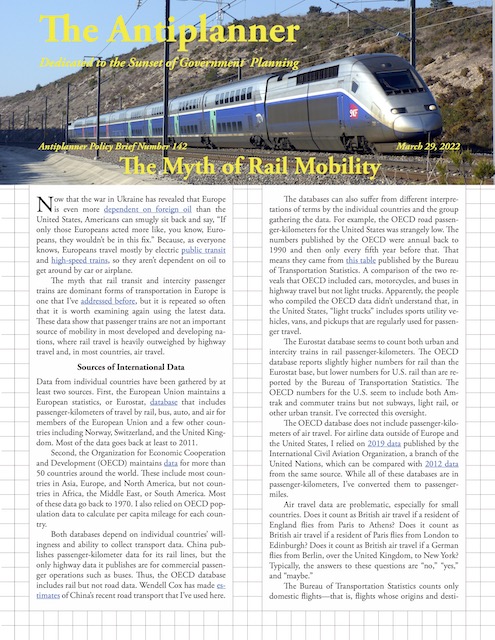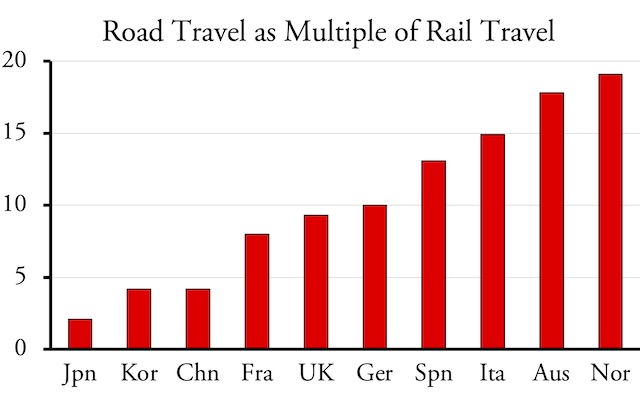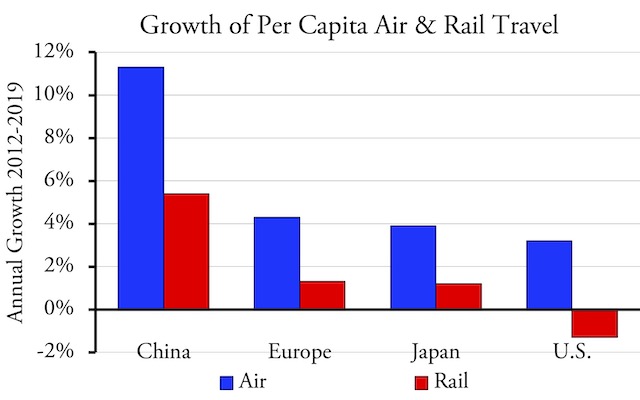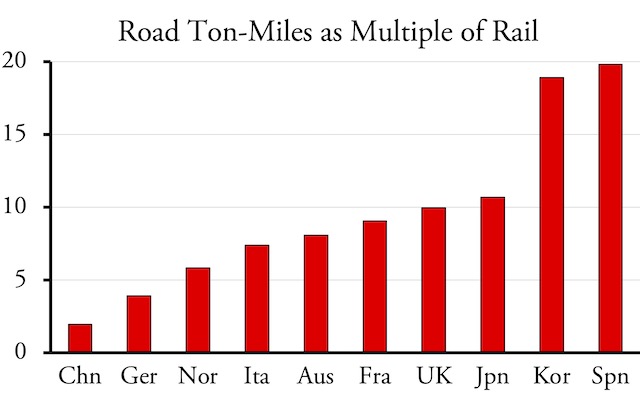Now that the war in Ukraine has revealed that Europe is even more dependent on foreign oil than the United States, Americans can smugly sit back and say, “If only those Europeans acted more like, you know, Europeans, they wouldn’t be in this fix.” Because, as everyone knows, Europeans travel mostly by electric public transit and high-speed trains, so they aren’t dependent on oil to get around by car or airplane.
 Click image to download a four-page PDF of this policy brief.
Click image to download a four-page PDF of this policy brief.
The myth that rail transit and intercity passenger trains are dominant forms of transportation in Europe is one that I’ve addressed before, but it is repeated so often that it is worth examining again using the latest data. These data show that passenger trains are not an important source of mobility in most developed and developing nations, where rail travel is heavily outweighed by highway travel and, in most countries, air travel.
Sources of International Data
Data from individual countries have been gathered by at least two sources. First, the European Union maintains a European statistics, or Eurostat, database that includes passenger-kilometers of travel by rail, bus, auto, and air for members of the European Union and a few other countries including Norway, Switzerland, and the United Kingdom. Most of the data goes back at least to 2011.
Second, the Organization for Economic Cooperation and Development (OECD) maintains data for more than 50 countries around the world. These include most countries in Asia, Europe, and North America, but not countries in Africa, the Middle East, or South America. Most of these data go back to 1970. I also relied on OECD population data to calculate per capita mileage for each country.
Both databases depend on individual countries’ willingness and ability to collect transport data. China publishes passenger-kilometer data for its rail lines, but the only highway data it publishes are for commercial passenger operations such as buses. Thus, the OECD database includes rail but not road data. Wendell Cox has made estimates of China’s recent road transport that I’ve used here.
The databases can also suffer from different interpretations of terms by the individual countries and the group gathering the data. For example, the OECD road passenger-kilometers for the United States was strangely low. The numbers published by the OECD were annual back to 1990 and then only every fifth year before that. That means they came from this table published by the Bureau of Transportation Statistics. A comparison of the two reveals that OECD included cars, motorcycles, and buses in highway travel but not light trucks. Apparently, the people who compiled the OECD data didn’t understand that, in the United States, “light trucks” includes sports utility vehicles, vans, and pickups that are regularly used for passenger travel.
The Eurostat database seems to count both urban and intercity trains in rail passenger-kilometers. The OECD database reports slightly higher numbers for rail than the Eurostat base, but lower numbers for U.S. rail than are reported by the Bureau of Transportation Statistics. The OECD numbers for the U.S. seem to include both Amtrak and commuter trains but not subways, light rail, or other urban transit. I’ve corrected this oversight.
The OECD database does not include passenger-kilometers of air travel. For airline data outside of Europe and the United States, I relied on 2019 data published by the International Civil Aviation Organization, a branch of the United Nations, which can be compared with 2012 data from the same source. While all of these databases are in passenger-kilometers, I’ve converted them to passenger-miles.
Air travel data are problematic, especially for small countries. Does it count as British air travel if a resident of England flies from Paris to Athens? Does it count as British air travel if a resident of Paris flies from London to Edinburgh? Does it count as British air travel if a German flies from Berlin, over the United Kingdom, to New York? Typically, the answers to these questions are “no,” “yes,” and “maybe.”
The Bureau of Transportation Statistics counts only domestic flights—that is, flights whose origins and destinations are both within the United States—as U.S. passenger-miles. BTS data also show, however, that from 2013 to 2019 there were more passenger-mile of international air travel (flights whose origin or destination were in the U.S. but whose other end was in a foreign country) than domestic air travel.
The issue of air space is even trickier. If someone drives from Chicago to Fargo, the miles they drive in Minnesota are counted as Minnesota driving miles. If they fly from Chicago to Fargo, should the miles they fly over Minnesota be counted as Minnesota flying miles? This question is particularly important in Europe, as there are entire countries that have only one commercial airport, so 99 to 100 percent of their airline miles are international travel. Even though residents of these countries might fly a great deal, none of it would be counted if only domestic travel were considered as the BTS does in the U.S.
Unfortunately, no country seems to keep track of how many passenger-miles their residents fly as opposed to residents of other countries. However, one table in the Eurostats database shows how many passenger-miles are flown over the air space of each European country. Since nearly all those flights have at least their origin or destination, if not both, within Europe, it provides a good indication of how much Europeans as a whole travel by air if not how much is done by residents of each individual country.
Proportion of Road to Rail Travel
Road travel greatly exceeds rail travel in every country in the OECD database, which means that roads probably exceed rails in every developed and developing country in the world. However, the range by which road travel exceeds rail travel varies widely. Not counting countries such as Iceland that have no railroads, road travel as a multiple of rail travel ranges from twice as much in Japan to more than 130 times as much in the United States.
While Americans travel on highways 133 times as much as they ride trains, most Europeans travel on highways about ten times as much and Chinese and Koreans four times as much as they ride trains.
According to official Japanese government data, Japanese rode trains nearly twelve times as many passenger-kilometers as roads in 1950, and more than three times as many in 1960. By 1970, however, the two were nearly tied and road travel first exceeded rail travel in 1971. In 2019, the average resident of Japan traveled almost 4,500 miles a year on roads and more than 2,100 miles a year on trains, making the Japanese more dependent on rails than the people of any other country.
Residents of China travel more than 600 miles a year on trains, but the best available estimates indicate they travel four times that much on roads. Road travel depends not only on miles of driving but on vehicle-occupancy rates, which tend to be closely related to average household sizes. Since Chinese families tend to be small, I assumed an occupancy rate of 1.3, but it could be higher. South Koreans also travel about four times as much on roads as on railroads.
Switzerland is more reliant on rail travel than any other European country. Swiss railroads carried 1,575 miles per resident in 2019. The only other European country that exceeded 1,000 miles was France, at 1,040. Swiss roads carried five times as many passenger-miles as Swiss railroads, and in other countries the differences are even greater: eight times in France, nine in the United Kingdom, ten in Germany, 13 in Spain, and 15 in Italy.
Spain has more route miles of high-speed rail than any country in the world other than China, yet its rail system isn’t used much. While Spanish roads carry around 5,000 passenger-miles per resident each year, Spanish trains carry residents fewer than 400 miles per year.
The Rail-Mobility Tradeoff
While total travel is most closely related to income, among wealthy countries there is a negative relationship between rail travel and total travel. In other words, the policies aimed at enhancing rail travel are detrimental to total personal mobility. At one extreme is Iceland, with no railroads and more than 14,000 miles of per-capita road travel, more than the total per capita travel of almost any other country except for the United States. U.S. roads hosted 16,000 miles of per capita travel while its railroads (including urban rail transit) carried 120 miles of travel per person in 2019.
Between Japan and Iceland/U.S., roads in France, Germany, and Great Britain carry an average of 7,000 miles of travel per resident, while their railroads carry around 800 to 1,000 miles; roads in Norway and Italy carry more than 8,000 miles of travel per resident while their railroads carry 700 to 800 miles; Canada is 10,000 by road and under 100 by rail. The correlation isn’t perfect, but policies emphasizing rail travel apparently tend to suppress total mobility. Gaining a few hundred miles of per capita rail travel means losing thousands of miles of per capita road travel.
One of the policies contributing to this result is punitive taxation of motor vehicle fuel. While Americans are complaining about $5 per gallon gasoline during the Ukrainian war, such prices have been the norm in countries such as Britain, the Netherlands, Italy, and Switzerland for many years, thanks to those countries’ high fuel taxes. In most countries, all or almost all taxes collected from fuel sales go into general funds, which are then used to heavily subsidize rail travel.
At the same time, residents of Iceland drive more than those of any other country except the U.S. despite the fact that fuel taxes there are $2.68 per gallon. While this is not quite as high as some other European countries, it is roughly five times as much in the United States. So more than fuel taxes must be at work in suppressing European mobility.
Growth of Rail Travel
Many countries have spent enormous amounts on high-speed rail for every little benefit. Per capita rail travel in France has been stuck at about a thousand miles per year since before 2010. Rail travel has also been growing slowly in Germany, Italy, and Japan. While rail travel in Spain has been growing a little faster, as previously noted the Spanish rail network still carried less than 400 miles per capita in 2019.
Between 2011 and 2019, per capita rail travel in Europe grew by 1.0 to 1.5 percent per year, and the fastest growth has been in countries that haven’t built any high-speed rail. These include the Czech Republic, Ireland, and Turkey. In Asia, rail travel in the decade before 2019 was growing fairly rapidly in Korea, at 6.0 percent per year, and China at 4.9 percent per year.
To the extent that European rail travel has grown, most of that growth has come from reduced commercial bus traffic, not reduced auto driving. In the European Union, rail’s share of passenger travel grew from 7.0 percent in 2002 to 8.0 percent in 2019. All of that growth came at the expense of bus travel, whose share shrank from 10.5 percent in 2002 to 9.2 percent in 2019. Auto travel’s share, meanwhile, grew from 82.5 percent in 2002 to 82.8 percent in 2019.
Growth of Air Travel
While European rail travel has grown slowly, air travel has been rapidly growing, thanks to deregulation and the introduction of low-cost airlines. With or without Norway and Switzerland, per capita air travel in the European Union grew by 4.3 percent per year between 2011 and 2019, about three times as fast as rail travel. While the average resident of those countries traveled about 650 miles a year by rail in 2019, they traveled almost 1,200 miles by air. Air travel thus has such a commanding lead over rail travel that rails will never be able to catch up.
Air travel is also rapidly growing in Asia. Between 2012 and 2019, domestic air travel in China grew at 10.7 percent per year, while in Korea it grew by 14.4 percent per year. Growth in Japan was only 3.9 percent per year (which is still far faster than rail), but international air travel in and out of Japan grew at 8.2 percent per year.
Europeans and Americans fly much more than they ride trains, and air travel growing faster than rail travel in both areas. Asians still ride trains more than they fly, at least domestically, but air travel is also growing much faster than rail travel.
It is possible that Japan’s high-speed trains slowed the growth of domestic air travel in that country. They may have that effect in Japan but not in China or Korea because of geography: Japan is a long, narrow country, and a single high-speed rail corridor the length of Honshu, Japan’s main island, is within easy reach of most of the population of the entire country.
If laid over a map of the United States, Honshu would effectively cover Boston to Charlotte, North Carolina, the corridor where 40 percent of intercity rail travel and more than 55 percent of transit ridership takes place in the U.S. Yet the population of the Tohoku, Tokaido, and Sanyo corridor is nearly twice that of the Boston-Charlotte corridor. Nowhere in the United States, and possibly nowhere else in the world, has such favorable geography for high-speed rail.
The Freight Tradeoff
Just as there is a tradeoff between an emphasis on passenger rail and total passenger mobility, there seems to be a tradeoff between passenger rail and rail freight. In the United States, ton-miles of freight shipped by rail is roughly tied with ton-miles shipped by truck. (It doesn’t appear so on this BTS table, but as I’ve explained in a previous policy brief, I suspect the truck ton-miles to be somewhat overestimated.)
In Asia and Europe, however, truck ton-miles vastly outweigh rail freight. In the European Union, 76.3 percent of freight is shopped by truck while only 17.6 percent is shipped by rail. To the extent that there are any trends, rail freight is losing ground, as its share was as high as 19.2 percent in 2011.
Rail’s share is even smaller in Asian countries and has been declining even faster. According to OECD data, in 1970, roads carried twice as much freight as rails in Japan, but by 2019 roads were carrying ten times as much. In 1978, rails in China carried 15 times as much freight as rails, but by 2018 roads were carrying three times as much (which declined to twice as much in 2019). Similarly, in South Korea, roads carried ten times as much as rails in 2001, increasing to 20 times as much by 2019.
U.S. railroads carry as many, or almost as many, ton-miles as trucks, but in other countries truck ton-miles vastly outnumber rail ton-miles.
As shown in a previous policy brief, transporting people by rail instead of by plane saves very little energy. But transporting freight by rail can save 90 percent of the energy used to transport freight by truck. Thus, it is more environmentally sound to emphasize the use of rail lines for freight than for passengers.
Rail freight loses out in countries where the rails are owned by the government because passenger trains are highly visible while freight trains are deep in the background of most people’s lives. Politicians dedicate the infrastructure they control to the purposes that gain them the most positive attention. Freight and conventional passenger trains share the same tracks and the effort to provide frequent passenger service crowds out freight trains. Freight and high-speed passenger trains don’t share the same tracks, but when given a choice between building high-speed rail infrastructure and improving freight rail infrastructure, political leaders—even those in China—choose the former and neglect the latter.
What We Should Learn
The United States can learn important lessons from transportation policies in Asia and Europe, but they are not the lessons claimed by anti-highway, pro-rail groups. The most important lesson is that an emphasis on passenger trains ends up hurting bus travel, total personal mobility, and rail freight, but it doesn’t measurably reduce auto travel as its adherents claim.
New passenger rail operations in the United States have never put a dent in auto travel, but the pro-rail people have always claimed this was because the country didn’t spend enough on passenger trains. But if Europe and Asia, which spend far more subsidizing their passenger trains than the United States, haven’t been able to reduce auto travel, there is no hope that such a thing will happen here. It’s time to give up the rail fantasy and live in the real world where automobiles are the most cost-effective forms of travel for short to medium distances, and airlines are the most cost-effective forms for medium to long distances, with no middle-ground in-between where rail is somehow optimal.











No the lesson here is Senile, old career politicians who kneecap domestic energy production make shitty presidents.
Even without Biden geopolitical aspects create shortages; temporary or longlasting is up to the peacemakers…… The Pandemic; China strangled and hoarded medical supplies to significant degree….. If they can do during their own emergency, think what they can do in an actual war.
The persistent belief gas will stay cheap,is “Wishful thinking” and it heralds what US foreign policy turned into in order to keep gasoline and oil cheap…..
Supposed; the US should have developed an anti-OPEC OPEC, consolidating Canada, US, etc and oil producing nations… It would have failed.
90% of the worlds oil is produced by state owned/controlled enterprises and 70% worlds oil is produced by regimes with less than desirable human rights records. Getting off globalized fossil fuel use is less an environmental thing, more a wartime survival concept. During WWII US was shipping coal/oil to UK.
Post WWII US flew 350,000 tons of food to Germany and Berlin and 1,500 tons of fuel a day.
Month ago, help UK energy issue, US tankers sent LNG to UK and EU.
Oil production alone is inconsequential without refinement capacity. It’s not like US learned that lesson. No one gave much thought to New Orleans or US deep south prior to Hurricane Katrina; namely One thing Energy analysts and environmentalists agreed upon; is rebuilding of wetlands…That government cared little and left NOLA to abandonment. No political influence, no willpower, no money to lobby heavily, mostly black city.
Not only do said wetlands protect the city but it safeguards the oil capacity not to mention refineries. 30% of US domestic oil came from Gulf of Mexico. How dumb does a president and congress have to be, to see 6-7 dollars a gallon gas overnight.
Because offshore oil companies go more than 3 miles offshore, they don’t contribute state tax revenue, Feds get it all. If Louisiana seceded and became its own nation, it’s own exclusion zone, collecting all oil revenue royalties, Louisiana wouldn’t be the poorest state in America they’d be like Emirates or Saudi Arabia; everyone would be riding Bentleys.
A growing number of businesses are using cargo cycles, a move towards more efficient and free-flowing city traffic that is now strongly backed by public authorities. Cargo transport in cities is extremely inefficient. As it stands,virtually 100 percent of it is done by cars, vans, commercial vans and trucks. However, these heavy vehicles often transport very light goods; even if their volume is significant, weight is not. How many packages have you got a box that could hold a basketball…to give you package the size of your cellphone. This volumetric inefficiency leads to massive fuel consumption, just to deliver you something as little as a pound.
Freight traffic takes up a large portion of total daytime road transport in cities, often as high as 50 percent in large cities. Cargo cycles are already used by courier services in (for example) Brussels, Londen, New York, Berkeley, Zürich, Basel, Vienna, Graz, Rome, Reggio and San Sebastian. These are often relatively small companies, but sometimes large logistic enterprises use cargo cycles, too. DHL applies cargo cycles in 15 Dutch cities. While many of us are not even prepared to change our landyachts for a small SUV, let alone their small SUV for a small car LET alone automobile for a bicycle, scooter, moped or some other conveyence…, we forget that neither of said vehicles can function without suited roads. Building and maintaining roads is very hard work, and history shows that it is far from evident to keep up with it. Smaller vehicles take lesser tolls on our already ravaged infrastructure…. With states pondering suspension of gas taxes, it’s gonna get more ravaged.
Hilarious when you see videos, Africa of women; carrying shit on their heads; funny, but they are amazing at moving stuff quickly. While they are for lack better still poor; they have phones, internet and growing demand. What they achieved is extraordinary efficiency at expense of Exact time. In the Industrialized world we use 50-1000x more energy to move One kilogram of goods than they do.
”
Freight and high-speed passenger trains don’t share the same tracks, but when given a choice between building high-speed rail infrastructure and improving freight rail infrastructure, political leaders—even those in China—choose the former and neglect the latter.
” ~anti-planner
There’s an argument to be made that a lot of the HSR track that was built was done in large part to free up capacity on existing tracks for freight.
Now, how much that’s actually played out, not sure. That would mean ending a local of those slow pokey local passenger trains. Ending those wouldn’t be a popular move.
”
Nowhere in the United States, and possibly nowhere else in the world, has such favorable geography for high-speed rail.
” ~antiplanner
It’s hard to find anything with the potential for 2 reasons:
a) There are ~65 million people living in the narrow 250 mile Osaka – Tokyo corridor. That is, thave UK or France mostly stuffed into a 250 mile long and maybe 30-40 miles at it’s widest. That’s more people than Kenya, South Korea, Columiba, Italy, et al.
Rare situation.
”
What they achieved is extraordinary efficiency at expense of Exact time. In the Industrialized world we use 50-1000x more energy to move One kilogram of goods than they do.
” ~lazythinker
There is nothing “extraordianry” about little girls being stolen of an education to huff water around because they don’t have pipes and pumps.
That’s knuckle-dragging crap.
kx1781: “There’s an argument to be made that a lot of the HSR track that was built was done in large part to free up capacity on existing tracks for freight.”
People can make that argument, but it isn’t working. Rail freight has dramatically declined in Japan, China, and many European countries.